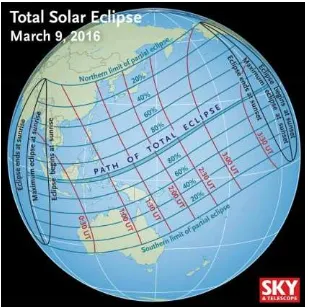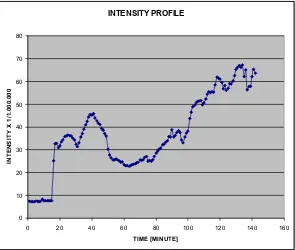Bambang Setiahadi and Dian Yudha Risdianto. Research on Partial Solar Eclipse 9 March 2016 Observed at Lapan Watukosek, Pasuruan
224
Isu-Isu Kontemporer Sains, Lingkungan, dan Inovasi PembelajarannyaRESEARCH ON PARTIAL SOLAR ECLIPSE 9 MARCH 2016 OBSERVED AT
LAPAN WATUKOSEK, PASURUAN
Bambang Setiahadi and Dian Yudha Risdianto Indonesian National Institute of Aeronautics and Space (LAPAN)
Watukosek, Gempol P.O. Box 04, Pasuruan 67155, Indonesia
Abstract. The partial solar eclipse was observed during the eclipse event on 9 March 2016. Research was focused on mainly the intensity decreasing and increasing during contact of Moon-disk with Solar-disk. During first contact decreasing in intensity is in focused. After minimum intensity phase we further continue to inspect the intensity increasing. We posed that the intensity profile has some degree of asymmetry during complete solar eclipse process.
Keywords: Partial eclipse, intensity, asymmetry
1. Introduction
A solar eclipse, such as occurred in Indonesia on 09 March 2016, occurs only at new Moon, when the lunar disk passes between the Earth and the Sun. other eclipse, a lunar eclipse takes place during full Moon, when the Moon passes through Earth's shadow. These alignments do not happen at every new and full Moon because the lunar orbit is tilted about 5° to Earth's orbital plane [1].
Three types of solar eclipse are possible (total, partial, and ring) depending on how deeply the Moon plunges into the Sun ans relative distance of Moon from Earth. If it goes all the way in, we see a total solar eclipse. The solar eclipse that occurred on 09 March 2016 was visible in some parts of Indonesia archipelago. The area along the total strip in Indonesia archipelago would experience total solar eclipse. The area off the total strip at a distance more than 200 km would experience partial solar eclipse [5].
The depth in percentage of the Moon disk plunged into the Solar disk depend on how far an observer away from the total strip. At Watukosek Solar Observatory the depth of the Moon disk plunge into the Sun disk is 83%. The percentage would admit observer to have continuous decreasing and increasing intensity profile from the Sun disk during initial contact, minimum phase, and last contact, as long as the local weather is good.
The eclipse occurred when the current zodiac of Moon is Pisces. Distance to the center of the Sun 148,548,153 km when the distance to the center of Earth 367,285 km. According to international time UTC, a solar eclipse would occur on 9 March 2016 which will be visible in Indonesia archipelago, both the total strip and partial strips. Area at a distance 160 km from the total strip would experienced partial solar eclipse as observed at Watukosek, Pasuruan East Java.
2. Method and Observation
Our method to observe the Sun is performed by automatic continuous tracking with a precision to follow the Sun disk within 32 second of arc of errors in both declination and east-west directions. In order to facilitate the automatic tracking, two pairs of solar cell with yellow-sensitive filter are placed inside a special telescope. The telescope serves as auto-guider telescope. We also put inside the telescope a photo-sensitive censor to serve as photo-detector cloud censor. The censor will serve as automatic switch to stop automatic tracking when solar intensity is too low. The guidance is then switched to constant stepping motor to follow solar avarage angular speed.
In early morning on 9 March 2016 the photo-sensitive censor was set to always tracked the Sun even though the
Bambang Setiahadi and Dian Yudha Risdianto. Research on Partial Solar Eclipse 9 March 2016 Observed at Lapan Watukosek, Pasuruan
sSSSSSSs 225
Seminar Nasional Pendidikan dan Saintek 2016 (ISSN: 2557-533X)observatory the Moon disk blocked the Sun disk up to 83% from its initial disk (see Figure 1). This setting, in some extent, is risky since sudden cloud coverage on the Sun disk will eventually stop the auto-guiding to function continuously. When this situation really happen, we track the Sun disk by a combination of manual guiding and east-west constant stepping motor.
Parallel with the auto-guider telescope is the main telescope to observe the Sun and flow the solar data images to a computer acquisition system. The stray light of the local atmosphere is reduced by HOYA G-533 green filter. The filter capable to reduce stray light of the atmosphere and at the same time to provide weak solar coronal green light during the partial solar eclipse process as well. In this paper we will not expose the weak coronal green light, since we focus to total decreasing and increasing profile during the partial solar eclipse.
The main telescope has 15 cm objective lens, but for the partial eclipse we put 6 cm aperture in front of the objective lens. The focal length is 225 cm with cube beam splitter to divide the Sun light to main CCD camera and to direct optical observation for inspection during initial setting and during cloud-covering trouble-some.
Figure 1: Solar Eclipse of 9 March 2016 (source: Sky and Telescope Magazine). Observation at Watukosek Solar Observation Site was around 83% moon disk coverage.
3. Results
The solar partial eclipse on 9 March 2016 went-on at early morning when the sun was low on the east horizon. The first contact was at 23:20 UT on 8 March 2016 according to UT system. Or it was just 06:20 Western Indonesian Time Zone. Low elevation solar observation is always unfavorable since low elevation observation usually faced optical obstacle such as trees, buildings, gates, high voltage electric towers, and so on. More than these are the low elevation atmosphere introduces long solar optical path and the color rather reddish due to atmospherical and dusts general absorption. The dust absorps solar light in nearly all wavelenght and degrades atmospheric tranparancy. It is also introduces optical defiency since we put green filter and ND5 filter in the telescope.
During observation the local weather was variable, especially the cloud coverage, since on March the rainy season is still go on until the end of May. Other local weather disturbing components are water vapor, rain, and haze will decrease optical observation efficiency as well [3].
The local atmosphere at this site during observation was optically rather adverse. The thick cloud covered the sun disk from initial contact with moon disk 23:20 UT to 23:38 UT. Until 23:54 UT transparancy of the atmosphere became better, but still variable. At 23:54 UT became clear eventhough the transparancy was still variable. It might be due to low elevation that caught more dust and water vapor.
We reduced the intensity of the sun to 1.0x10-5 weaker than original solar photospheric intensity by the use of
Bambang Setiahadi and Dian Yudha Risdianto. Research on Partial Solar Eclipse 9 March 2016 Observed at Lapan Watukosek, Pasuruan
226
Isu-Isu Kontemporer Sains, Lingkungan, dan Inovasi PembelajarannyaThe solar image was recorded in grey scale ranges from minimum or 0 to maximum or 255 digital intensity. The brightness solar intensity should not attain the maximum at 255 grey scale. The maximum intensity, when the sky is clear, is set at 100 in grey scale, since we anticipated the occurance of solar white flare maximum intensity not to exceed 255 grey scale.
The maximum intensity after the last contact might lay at 80 to 90 grey scale that means it is 80x10-6 to 90x10-6.
(see Figure 2). The minimum intensity should lay between 0x10-6 to 10x10-6 and it should attained at 00:25 UT.
In fact, we had thick cloud coverage resulted very low intensity around 9x10-6 on grey scale. At 23:29 UT the
cloud seems passed over, but other clouds again blocked the sun until 23:35 UT. The clouds seem passed and the weather became better 35 minutes after assumed first contact or at 23:54 UT.
After the sky was relatively clear, the intensity seemed to follow assumed intensity decreasing due to increasing moon disk coverage (see Figure 2). It went to minimum intensity until 00:25 UT on 9 March 2016. The intensity increased after minimum since the moon disk gradually left solar disk until completely distangled at 01:39 UT. The symmetry situation is similar as pointed out in [2]. From Figure 2 it is obvious that the sky condition and the weather frequently interfere the sun light. It might interfered by dust and haze that degraded atmosphere’s transparancy [3]. The total time partial eclipse is 2 hours and 17 minutes.
INTENSITY PROFILE
Figure 2: intensity profile during partial solar eclipse lasted within 2 hous and 17 minutes. At initial contact the thick clouds covered completely the solar disk made the intensity dropped to a minimum below 10x10-6.
4. Discussions
Resulted intensity profile during the partial solar eclipse observed from Watukosek solar observatory is far from smooth and symmetry. These are due to variation in sky brightness and weather. Since on March the rainy season is not yet ceased. In rainy season there always clouds, water vapor or moisture and haze that degraded atmospheric optical quality.
The clouds may obscure completely the solar light during observation as exhibited on the Figure 2. The first contact of partial eclipse was completely obscured the solar intensity such that we had minimum solar intensity below 10x10-6. After the clouds went away from the line of sight, the thin clouds and might be the combination
Bambang Setiahadi and Dian Yudha Risdianto. Research on Partial Solar Eclipse 9 March 2016 Observed at Lapan Watukosek, Pasuruan
sSSSSSSs 227
Seminar Nasional Pendidikan dan Saintek 2016 (ISSN: 2557-533X)The profile exposed generally that solar observation during rainy seasons with low elevation will heavily disturbed by atmospheric conditions. Haze and dust along the line of sight are amongst difficult to avoid and to remove from the optical observation.
References
[1]. Consialls, A., Babot, N., Serrado, G., Ganau, A. (2015), Comparative Study of Two Solar Eclipses in the 21th Century, Institute Guindavoles, Lleida, Spain.
[2]. Koepke, P., Reuder, J., Schween, J. (2001), Spectral Variation of the Solar Radiation During an Eclipse, Meteoroligische Zeitschrift, Vol 10, No. 3.
[3]. Kumar, S.S., Rengaiyan, R. (2011), Influence of Solar Eclipse on Seawater, Natural Science, Vol. 3, No. 1.
[4]. Liu, Y., Shen, Y.D., Zhang, X.F., Liu, N.P. (2012), Using a New Sky Brightness Monitor to Observe the Annular Solar Eclipse on 15 January 2010, Solar Physics, 4: 49.

